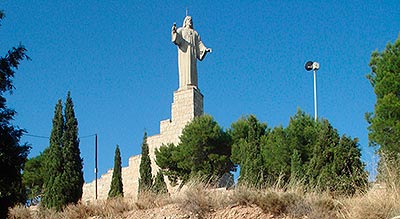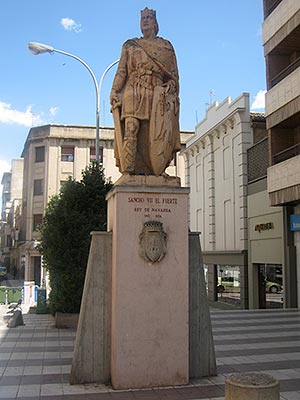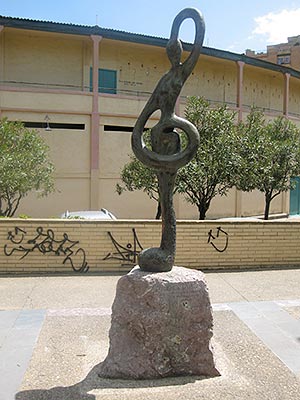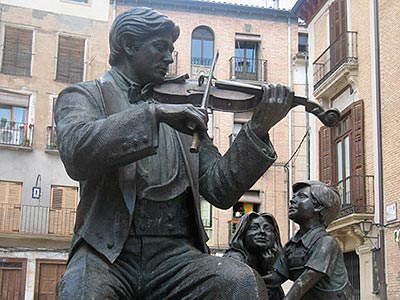BRINGING HERITAGE CLOSER. TUDELA
5 September 2008
Art, report and collective identity: The commemorative monument in the city of Tudela.
Mr. José Javier Azanza López. Chair of Navarrese Heritage and Art.
Throughout the twentieth century and during the first years of the twenty-first, Tudela has been gathering in its streets, squares and gardens, a rich bequest of monumental sculpture that not only contains in itself an artistic interest, but also sociological, as its presence helps to define the report and collective identity of the riverside capital and its inhabitants.
Given its special nature, the understanding of any memorial involves the knowledge of its formal components, i.e., the location of the monument, the materials used in its execution, and the typology and style of the work. reference letter However, those aspects related to management should also be taken into account, such as the motives that justify the creation of the monument, the promoters and financing of the monument, and the official inauguration ceremony.
From the formal point of view, the commemorative monument of Tudela sample great typological variety, from the standing figure to the statuary in group, through the bust and the sculptural relief. As for the artists and tendencies, names such as Fructuoso Orduna, Antonio Loperena, Ricardo Varela, the Aragonese Ángel Bayod and the Oviedo-born Mauro Álvarez belong to the figurative realist current. Other artists take figuration as a starting point for their works, but the final result sample the influence of various trends ranging from the geometrization of Manuel Aramendia, to the organicism of José Antonio Eslava, and the symbolism of Martina Lasry and Pedro Jordán. And there is also a conceptual and even abstract interpretation of Tudela's commemorative sculpture, proposals that come from the hand of Manuel Clemente Ochoa from Cascantino.

Monument to the Sacred Heart of Jesus. Victor Eusa and C. Buzzi, 1942
As for the monumental management , a fundamental aspect is that of the promoter or commissioner who covers the costs of the commemorative sculpture, an area in which the City Council of Tudela has distinguished itself in its goal of embellishing the city, while preserving its history and the report of its illustrious characters. The Provincial Council, the Government and the Parliament of Navarre have also contributed to finance some of the monuments erected in Tudela. Other cultural and economic entities, such as the Caja de Ahorros de Navarra, the Real Sociedad Económica Tudelana de Amigos del País, the Orden del Volatín and the Rotary Club, have promoted the construction of monuments in the capital of Tudela; without forgetting those monuments erected by popular subscription, a system that provided the illusion of participating in a collective business , which is a consubstantial element of the idea of a commemorative monument. The inaugural act of the monument was also of great importance, which sometimes coincided with festive celebrations or public events of various kinds in the riverside city, whose simultaneity gave it greater relevance. It is attended by quotation authorities in charge of the protocol speeches, personalities from the world of culture, and even very often the artists responsible for the monument themselves.

Monument to Sancho VII the Strong. Antonio Loperena, 1983
Once the general aspects of Tudela's commemorative monuments are known, their individualized study allows us to establish four large groups, according to iconographic criteria.
The first group includes historical events, among which we can mention the Monument to the Fueros (1967).
The second group, group , is made up of historical figures linked to the city, which in turn can be subdivided into three categories. First, the monarchs: Sancho VII el Fuerte (Antonio Loperena, 1983), Muza ibn Muza (Antonio Loperena, 1996), Carlos III el Noble (Pedro Jordán, 1999). Next, the characters linked to politics and social welfare: José María Méndez Vigo (Fructuoso Orduna, 1929), Father Lasa (Pedro Jordán, 1997). Finally, the world of literature and the arts: José María Iribarren (Antonio Loperena, 1972), Benjamín de Tudela (Martina Lasry, 1984, and Ricardo Varela, 1994), Fernando Remacha (Pedro Jordán, 1998).
The third group is formed by monuments of a religious nature, closely linked to the popular devotion of Tudela. This is the case of the Monument to the Sacred Heart of Jesus (Víctor Eusa and C. Buzzi, 1942), erected as a spiritual beacon at the top of the Cerro del Castillo, from which it extends its protection to the city and the whole region. And the monument to the Immaculate Heart of Mary (Enrique Delso and Angel Bayod, 1956), inaugurated on a hill near the Tower of Monreal by the Nuncio of His Holiness in Spain, Monsignor Hildebrando Antoniutti.
Finally, a large number of monuments in Tudela are of a symbolic-sociological nature, either because they have a strong symbolic component, or because they are related to the world of work, extolling a profession or official document, or because they keep alive the memory of certain customs and traditions rooted in the riverside town. This is the case of the Monument to the Hortelano (Antonio Loperena, 1973), Monument to the Jota (Antonio Loperena, 1985), Monument to the Three Cultures (Manuel Clemente Ochoa, 1997), Monument to the Hortelana (José Antonio Eslava, 2002), Monument to the Violinist (Mauro Álvarez, 2002), Monument to Popular Music ("Atabal", Manuel Aramendia, 2003), Monument to the Victims of the Civil War ("Conciliation", Manuel Clemente Ochoa, 2006).
In final, Tudela shows its true signs of identity through the commemorative monuments that embellish the city.

Monument to Fernando Remacha ("La Musa"). Pedro Jordán, 1998

Monument to the violinist. Mauro Alvarez, 2002
PROGRAM
TUESDAY, 2 SEPTEMBER
Place: Tudela. Dean's Palace
16.30 h: Opening and presentation of the course
16.45 h. The recovery of the ornamentation of Tudela Cathedral
Ms. Mercedes Jover Hernando. Chair of Navarrese Heritage and Art
17.45 h. Coffee break
18.15 h. Santa María de Tudela and the medieval architecture of the Ebro Valley
Mr. Javier Martinez de Aguirre Aldaz. Complutense University of Madrid
19.15 h. Artistic relations between Aragon and Navarre in the 15th century: the case of Tudela Cathedral
Ms. Carmen Lacarra Ducay. University of Zaragoza
20.15 h. visit guided tour of the cloister of Tudela Cathedral
WEDNESDAY, 3 SEPTEMBER
Place: Tudela. Dean's Palace
16.30 h. Architecture and the city in the 16th century
Ms. María Josefa Tarifa Castilla. Chair of Navarrese Heritage and Art
17.30 h. Coffee break
18.00 h. Illustrious women of the Renaissance in the Magallón palace
Ms. Mª Concepción García Gainza. Chair of Navarrese Heritage and Art
19.00 h. visit to the Magallón palace
THURSDAY, 4 SEPTEMBER
Place: Tudela. Dean's Palace
16.30 h. Art and devotions in Tudela between the 16th and 18th centuries
D. Ricardo Fernández Gracia. Chair of Navarrese Heritage and Art
17.30 h. Coffee break
18.00 h. visit guided tour of the convents of the Company of Mary, Capuchin and Dominican nuns in Tudela
FRIDAY, 5 SEPTEMBER
Place: Tudela. Dean's Palace
16.30 h. Art, report and collective identity: The commemorative monument in the city of Tudela
Mr. José Javier Azanza López. Chair of Navarrese Heritage and Art
17.30 h. Coffee break
18.00 h. Tudela and Navarrese painting from the period between the centuries
D. Ignacio J. Urricelqui. Chair of Navarrese Heritage and Art
19.00 h. The Bardenas and La Mejana. Landscape and still life in Tudela painting
D. Manuel Motilva Albericio. Director of the Muñoz Sola Museum in Tudela.
20.00 h. Closing ceremony
